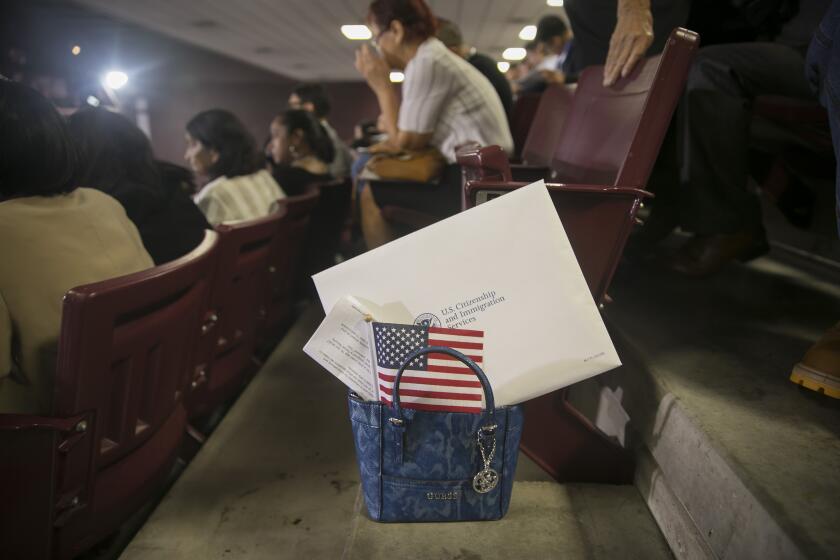On a California ranch, signs of a slowdown in illegal immigration
Back in the late 1990s, when illegal immigrants tramped across his ranch every day, Robert Maupin fortified his rickety fence with additional strands of wire. Then he added chain link fencing and ringed his 250-acre property with cameras.
But every night he would encounter jagged holes in the fence and litter-strewn trails through his clusters of live oak trees.
FOR THE RECORD:
Border apprehensions: A chart with an article in Wednesday’s Section A about a decline in apprehensions of illegal immigrants along the U.S.-Mexico border did not indicate that the numbers shown for apprehensions were in thousands. The number of illegal immigrant apprehensions for fiscal 2007 in Arizona was 416,000, and for fiscal 2009 it was 248,000. For California, the decline was from 208,000 to 154,000. —
These days, the 70-year-old rancher still walks the fence every day with his three dogs, but there are no longer any holes to patch. Since the U.S. Border Patrol erected an 18-foot barrier nearby and boosted staffing in this backcountry 60 miles east of San Diego, relative tranquility has returned, at least for now.
“Every time I see [Border Patrol agents] I congratulate them on the good job they’re doing,” said Maupin, whose property sits right on the California- Mexico line, “because there’s nobody walking on my place except me and the cows.”
Although Arizona remains the leading illegal immigrant gateway into the U.S., prompting a controversial immigration law and calls for increased border security, the California frontier is quieter than it has been in years.
From the ocean-view canyons to the sand dunes of the Imperial Valley, arrests of illegal immigrants and assaults on agents are down significantly, continuing the trend of recent years.
Most illegal immigrants, seeking easier passage through wide-open borders, shifted from California to Arizona about 12 years ago, but authorities here continue to brace for the worst, believing that increased enforcement in the neighboring state could send immigrants back to their old crossing points.
The rebound effect hasn’t materialized, in part because California now has some of the greatest concentrations of barriers and staffing anywhere along the border.
Fencing now lines about two-thirds of California’s boundary, with all but remote or mountainous areas blocked. Cameras mounted on mobile and permanent towers alert authorities to incursions in deserts and mountain valleys. Newly cut roads allow access to once-remote areas within minutes.
In the last two years, the number of agents in California has been boosted 12%, from 3,200 to 3,594. They staff 11 checkpoints on freeways and highways leading to San Diego and Los Angeles. Plainclothes agents have locked up many of the load-car drivers who used to speed in their immigrant-laden cars the wrong way down freeways.
After several years of incremental gains — starting with Operation Gatekeeper in the mid-1990s, which sealed off much of the San Diego-Tijuana border — authorities say they have taken back miles of rural terrain once controlled by Mexican smugglers.
“We took away 30 miles that they used to operate in with impunity,” said Rodney Scott, acting deputy chief patrol agent in charge of the Border Patrol’s San Diego sector. “The days where they could hop the fence and blend in the local population within seconds … those days are pretty much gone.”
Not everyone is convinced things will stay this way. Many residents say that the troubled economy, not increased enforcement, is the biggest factor deterring immigrants. And the killing last summer of Agent Robert Rosas by Mexican bandits was a chilling reminder of the ruthlessness of smuggling groups.
Maupin and many other backcountry residents still lock their gates and keep their cameras on every night, anticipating the worst. In 2003, an illegal immigrant murdered a local woman. Earlier this year, an Arizona rancher was killed.
On his daily patrols around his property, Maupin totes a rifle slung over his shoulder and a Glock handgun strapped in his thigh holster. “That Arizona rancher got killed because he dropped his guard,” Maupin said.
The stocky Maupin, an outspoken former gun store owner — “I’m small of stature, large of mouth,” he said — first moved to the ranch with his parents in the 1940s, when the fence that marked the border was meant to keep the cows from straying.
Mexican cowboys crossed back and forth to work in the thriving cattle industry. “Back then, nobody cared,” Maupin said. “They didn’t want to live up here. They just came up here to work and then they’d go home.”
Things began changing in the 1980s, when small groups started crossing his property, becoming more brazen every year. They cut the fence instead of climbing over. Drug-laden vehicles began motoring through the sagebrush. Once, Mexican army soldiers came across and disarmed him after he reported suspicious drug activity at a Mexican ranch nearby, Maupin said.
By the late 1990s, immigrants were streaming across every night, Maupin said. He brought in friends to help him patrol, including a former Marine sniper who gave him shooting lessons. They’d confront and hold groups regularly until agents picked them up.
One cold night, a lost group knocked on his door. Maupin and his wife, Jeanette, 69, gave them hot chocolate and let them warm up by the fireplace. “There were two little girls with them, in cotton dresses and sandals, shivering,” she said.
Maupin estimates that over the years, he and his friends rounded up thousands of illegal border crossers.
He strengthened the original 100-year-old fence with rebar and barbed wire, but nothing much worked until border authorities last year plugged gaps in the government’s original fence and added the 18-foot-high barrier east of his property.
After Rosas was slain last July, the agency beefed up even more. Agents now man an outpost on a rock mountain overlooking Maupin’s property and drive by regularly along the border road.
It’s been about eight months since he has had to repair his fence, a record, he said. Still, with organized crime groups battling south of the border, he believes threats remain. He points to the towering barrier nearby.
“When they put another one like that, over here — a double fence,” Maupin said. “Then I’ll have to stop calling it the department of homeland insecurity.”
More to Read
Start your day right
Sign up for Essential California for news, features and recommendations from the L.A. Times and beyond in your inbox six days a week.
You may occasionally receive promotional content from the Los Angeles Times.







